



















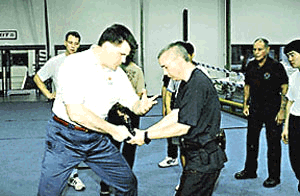 �@ �@
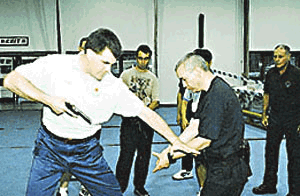 US Pressure Point Control Tactics expert Tom jost demonstrates a weapon retention technique in one swift move | |
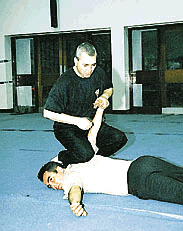 �@�@�@�@�@�@�@�@�@�@�@ �@�@�@�@�@�@�@�@�@�@�@
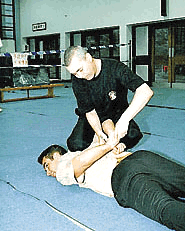
Less is best : PTS trainer demonstrates tactical handcuffing using Pressure Point Control Tactics | |
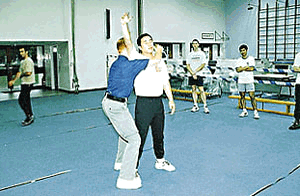 ( 1 )�@�@�@ | 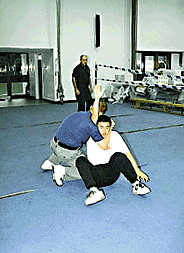 ( 2 ) |
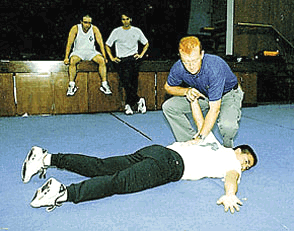 ( 3 )�@�@�@ | 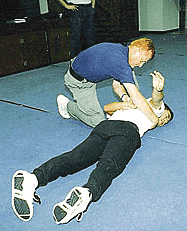 ( 4 ) |
| Any physical move that is
not simple is discarded: Here Clive Howard of the Police Training School,
immobilises his subject, leads him into the position, then handcuffs him - all in four rapid, tactical moves | |

| IT may not
have the choreographed finesse of martial arts, but when it comes to
police officers protecting themselves (as well as an assailant for that matter)
in real life " use of force " situations, Pressure Point Control Tactics (PPCT)
have proven to be extremely successful. So successful that law enforcement agencies
around the world have implemented the techniques that are designed to control
aggressive and resistive behaviour.
�@Pressure Point Control Tactics is a law enforcement self-defence system designed by police for police, which is why its various techniques always end with the subject on the ground in the handcuff position. The tactics make use of gross motor skills and response options that enhance a police officer's performance and reaction when his/her life is on the line - like prevention his weapon from being snatched from hand or holster, or to knock a weapon out of the hands of and an attacker. �@The training develops the police officer's actions based upon predicting resistive behaviour with a set of preorganised control techniques. �@The procedures are based on the principlw that under the psychological and physiological stresses associated with a " use of force " situation, the human body can only react using gross motor skills associated with the large muscle groups - the arms and the legs. In a non-lethal force arrest or deadly force situation it is a proven fact that performance of fine and complex motor skills (like finger or eye movement) deteriorate and are slowed down. PPCT uses only gross motor skills which are easy to learn and do not require the police officer to think about a complicated series of movements. " Less is best ". �@Pressure Point Control Tactic techniques are simpicity themselves with the number of physical movements kept to a minimum. �@Defensive skills are matched to a specific threat stimulus. That's because reaction time is markedly increased when a second option is given. And in a " use of force " situation a millisecond can result in tragedy. Speed is the priority - not gracefulness. �@The beauty of Pressure Point Control Tactics is that you don't have to be a Bruce Lee to employ the techniques. PPCT training focuses on training the average police officer with average physical abilities. �@Recently Pressure Point Control Tactics staff from the US and Australia have been training and qualifying officers as Defensive Tactics Instructors at the Police Training School. �@PPCT experts Tom Jost, Desmond Morrison and Paul Hartley have qualified 29 Hong Kong Police basic instructors and 12 instructor trainers. These officers return to their units to teach vital skills such as tactical handcuffing, weapon retention, baton techniques, controlling resistance and self defence. �@"Although PPCT Defensive Tactics has been taught at PTU for the past two years, " says Clive Howard, CDMI PTS, "the Force was very short of qualified instructors. This recent training has established an instructor cadre who are now training the rest of the Force in this internationally recognised defensive tactics system." �@One of the newly qualified instructors, Chris Pedder, SIP HQ EU K/W, had nothing but praise for the course: "The Force has a moral and legal obligation to its officers and to the public to provide a humane, non-violent way of controlling resistance. And that's what PPCT is all about. By mastering these techniques, Hong Kong police officers can now use, when necessary, the most effective yet minimum amount of force to subdue a subject." |

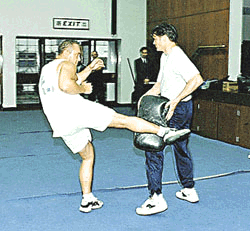
Instant reaction: Using gross motor skills - a sharp shinkick to an assailant's thigh - the system does not require police to think about a complicated series of movements | 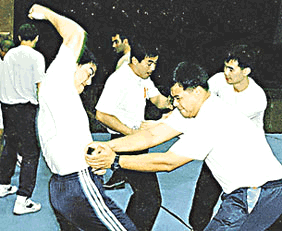
Becoming trainers: Hong Kong Police officers practice preventing assailant's from snatching their weapons |
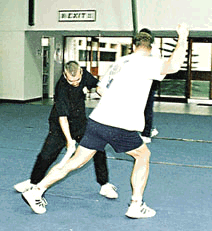
Baton technique guaranteed to subdue a subject without doing serious harm | 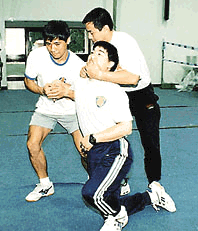
Speed is the priority - not gracefulness: Hong Kong Police trainers using two simple, yet extremely incapacitating holds, subdue their subject onto his knees, then down to the ground and into the handcuff position |

![]()
